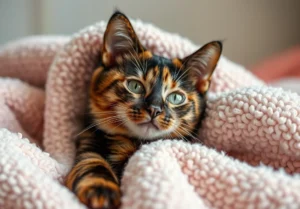Cats always seem to have a natural warmth to them that can be quite comforting, especially on a chilly day. Have you ever wondered why your furry feline friend feels so much warmer than you do? Let’s explore the reasons behind why cats are warmer than humans.
Differences in body temperature regulation
Cats are warm for a reason – they actually have a higher average body temperature than humans! While our normal body temperature hovers around 98.6 degrees Fahrenheit, our feline friends typically run a toasty 100.5 to 102.5 degrees. This higher internal heat means they radiate more warmth, making them feel like a cozy little heater when they snuggle up to you on a chilly evening.
Fur as insulation
A cat’s fur coat is not just for show – it’s a powerhouse insulator that keeps them toasty warm. Each hair on a cat’s body works together to create a layer of trapped air close to their skin, acting as a natural barrier against the cold. This fluffy insulation not only keeps them snug and comfy but also makes them adept at holding onto their body heat, making them feel warmer to the touch.
Insight: Cats’ fur isn’t just about looking cute – it’s a sophisticated thermal regulation system that helps them stay comfortably warm in a variety of temperatures.
- Cats groom meticulously to keep their fur in top condition, ensuring maximum insulation efficiency.
- Different cat breeds have varying fur thickness and length, impacting their ability to retain heat effectively.
- Providing a warm, cozy spot for your cat to rest can help them conserve body heat and stay comfortably warm.
Metabolic rate comparison
Cats are warmer than humans primarily due to their higher metabolic rate. This means they generate more internal heat to keep themselves cozy. Compared to humans, cats have a faster metabolism, which results in more energy production and heat generation within their bodies. This elevated metabolic rate is like having a built-in furnace, making cats naturally warmer creatures than us.
Sunbathing habits
Cats are masters at sunbathing, and this habit plays a significant role in keeping them warm. When cats soak up the sun, they absorb heat through their fur, which helps in regulating their body temperature. Not only does this sunbathing routine provide warmth, but it also contributes to their overall well-being by ensuring they stay toasty and comfortable. So next time you see your cat basking in the sunlight, know that they’re not just enjoying a lazy afternoon; they’re also keeping themselves nice and warm.
Additional unique insight:
Here are a few additional tips to keep your furry friend warm and cozy during colder days: – Provide a warm and soft blanket for them to snuggle in. – Consider getting a heated pet bed to give them extra warmth. – Keep their sleeping area away from drafts to prevent chilly air from affecting them.
Heat retention in extremities
Have you ever noticed how cats’ paws and tails always feel toasty warm? Well, it turns out that cats have a clever trick up their furry sleeves when it comes to heat retention in their extremities. Cats have a specialized circulatory system that helps them keep their paws and tails warm by conserving heat. This means that even when the rest of their body is feeling a bit chilly, their extremities stay nice and cozy. So, the next time you feel a cat’s warm paws, you can thank their clever circulatory system for keeping them toasty.
Cozy sleeping spots
Cats seem to have an uncanny ability to find the warmest, coziest spots to curl up and take a catnap. One reason for this behavior is their wild ancestry. In the wild, cats would seek out warm, sheltered spots to rest and conserve energy. This instinct has been passed down through generations, leading our beloved feline friends to always search for the comfiest places to snooze. So, if you find your cat snuggled up in a sunbeam or nestled in a pile of blankets, they’re just following their natural instincts to stay warm and cozy.
Additional unique insight:
Next time you catch your cat napping in a sunbeam, consider this: Cats’ fur acts as a natural insulator, helping to trap heat close to their bodies and keep them warm. This means that when your kitty is basking in the sun or cuddled up in a warm spot, their fur is working hard to maintain their body temperature. So, while their cozy sleeping spots play a big role in keeping them warm, their furry coats are also essential in helping them stay comfy and toasty.
Heat distribution through grooming
Cats are naturally excellent groomers, using their rough tongues to lick their fur. This grooming action helps distribute oils produced by their skin throughout their fur, creating a protective barrier that traps heat close to their bodies. By spreading these oils, cats can effectively retain their body heat, keeping them warmer than humans. Additionally, the act of grooming also helps cats remove any dirt or debris from their fur, allowing for better insulation and heat retention.
Circulation differences
One key factor that contributes to why cats are warmer than humans is the differences in circulation between the two species. Cats have a higher blood volume relative to their body size compared to humans. This means that blood circulates more efficiently through their bodies, allowing for better heat distribution. Cats also have a higher body temperature range than humans, typically ranging from 100.5 to 102.5 degrees Fahrenheit. This higher body temperature, combined with their efficient circulation, helps cats naturally maintain a warmer internal temperature than humans.
Additional unique insight:
- Cats have a heat-conserving adaptation called the “rete mirabile,” a mesh-like network of arteries and veins in their legs that helps retain heat by minimizing heat loss when blood flows back to the heart. This specialized heat exchange system contributes to the overall warmth of cats compared to humans.
Interesting facts about cat behavior
Did you know that cats have a natural instinct to seek out warm places to rest? They often curl up in sunny spots or cozy up next to a warm body, like a human or another pet, to regulate their body temperature. This behavior helps them stay warm, especially during colder months.
Another interesting fact is that cats have a higher body temperature than humans, typically ranging from 100.5 to 102.5 degrees Fahrenheit. This higher internal temperature helps cats stay warm and aids in their digestion and overall health.
Cats also have a special way of conserving heat by keeping their extremities, like paws and ears, warm. You may notice your cat tucking their paws under their body or wrapping their tail around themselves to retain heat. This behavior is an efficient way for them to maintain their warmth.
In addition, cats are masters of finding the perfect cozy spot. They may seek out blankets, soft pillows, or even your lap to snuggle up and stay warm. By observing their behaviors, you can get a glimpse into how cats naturally regulate their body temperature and enjoy their warm companionship even more.
Next time you see your cat basking in a sunbeam or cuddled up next to you, remember these fascinating facts about cat behavior and appreciate the unique ways in which they stay warm and comfortable. Your furry friend’s warmth is not just a sign of affection but also a result of their innate instincts and physiology.
Unique insight: Cats have a special layer of fat beneath their skin called subcutaneous fat, which helps insulate them and retain body heat. This fat layer, combined with their fluffy fur coat, contributes to their overall warmth compared to humans. So, the next time you feel your cat’s toasty warmth, know that it’s thanks to their clever design of fat and fur working together to keep them cozy.
Alex, a passionate animal lover, has experience in training and understanding animal behavior. As a proud pet parent to two dogs and three cats, he founded AnimalReport.net to share insights from animal experts and expand his knowledge of the animal kingdom.




